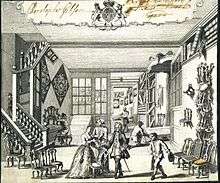Trade card


A trade card is a square card that is small, but bigger than the modern visiting card, and is exchanged in social circles, that a business distributes to clients and potential customers. Trade cards first became popular at the end of the 17th century in Paris, Lyon and London. They functioned as advertising and also as maps, directing the public to the merchants' stores (no formal street address numbering system existed at the time).
The trade card is an early example of the modern business card. Some businesses began to create increasingly sophisticated designs, especially with the development of color printing. A few companies specialized in producing stock cards, usually with an image on one side and space on the other side for the business to add its own information. As the designs became more attractive and colorful, collecting trade cards became a popular hobby in the late 19th century, since color images were not yet widely available.
In its original sense, the "trade" in trade card refers to its use by the proprietor of a business to announce his trade, or line of business. By moving into the realm of collecting, trade cards gave rise to the trading card, the meaning now shifting to the exchange or trade of cards by enthusiasts. Some cards, particularly those produced by tobacco companies featuring baseball players, later developed into collectibles and lost their function as a business advertisement.
 Lithographed trade card advertising Murray & Lanman Florida Water Cologne
Lithographed trade card advertising Murray & Lanman Florida Water Cologne Back of a German Liebig Extract of Meat Trade Card from 1885
Back of a German Liebig Extract of Meat Trade Card from 1885 Early 19th-century English-language trade card of John Maria Farina, cologne manufacturer, showing Farina Haus, Köln.
Early 19th-century English-language trade card of John Maria Farina, cologne manufacturer, showing Farina Haus, Köln.
See also
- Advertising postcard
- Baseball card — The earliest baseball cards were trade cards.
- Cigarette card — a type of trade card packaged in tobacco products.
- Postcard
- Prizes — Trade cards were some of the earliest "prizes" packaged in retail products.
- Trading card — Trade cards were the ancestors of trading cards.
Further reading
- Maxine Berg and Helen Clifford, "Selling Consumption in the Eighteenth Century: Advertising and the Trade Card in Britain and France," Cultural & Social History (2007) 4#2 pp 145-170
External links
| Wikimedia Commons has media related to Trade cards. |
- Trade Card Valuations
- Victorian Tradecards
- Brooklyn Public Library: Fulton Street Trade Card Collection
- Catalogue of heraldic tobacco and trading cards
- Iowa Digital Library: Victorian Trade Cards Digital Collection
- Victorian Trade Card Collection on Flickr
- 17th-18th century French and German Trade Card Collection at Waddesdon Manor Online
- The HSP trade cards collection, which includes nineteenth century trade cards from Philadelphia and surrounding region, are available for research use at the Historical Society of Pennsylvania.